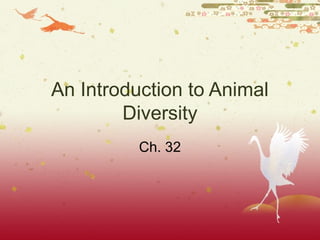
AP Biology Ch 27 Introduction to Animal Diversity
- 1. An Introduction to Animal Diversity Ch. 32
- 2. The Animal Kingdom Animals are: Multicellular Heterotrophic Eukaryotic Composed of tissues that develop from embryonic layers
- 3. Bacteria & archaea Protists Plants Fungi Animals Cells Prokaryotic Eukaryotic Eukaryotic Eukaryotic Eukaryotic Nutritional mode Photoautotroph Chemoautotroph Photoheterotroph chemoheterotroph Photoauto- trophs Hetero- trophs Mixotrophs Photoauto- trophs Hetero- trophs, Exo- enzymes, absorbtion Heterotrophic Reproduction Binary fission - asexual Some sexual, some asexual Sexual, alternation of generations Asexual budding Sexual and asexual Sexual, few asexual
- 4. Reproduction & Development Usually a small, flagellated sperm fertilizes a larger egg to form a diploid zygote Zygote goes through cleavage Cell division by mitosis without cell growth
- 5. Reproduction & Development cleavage leads to the formation of a hollow ball of cells called a blastula
- 6. Reproduction & Development After blastula comes gastrulation (to form a gastrula) Layers of embryonic tissues form These layers will become the various parts of the body
- 7. Reproduction & Development Many animals have a larval stage Larva is a sexually immature form Morphologically distinct Eats different food than adult May live in different habitat than adult Larvae undergo metamorphosis and transform into adults
- 8. Quick Think Complex early developmental patterns such as the formation of a blastula and a gastrula are shared by diverse animals ranging from grasshoppers to clams to humans. What does thisWhat does this observation imply about theobservation imply about the timing of the origins of thesetiming of the origins of these processes in animal evolution?processes in animal evolution?
- 9. The history of animals may span more than a billion years Huge diversity of fossil species
- 10. Neoproterozoic Era 1 billion to 542 million years ago Earliest known fossils Most animal phyla began to evolve during this period
- 11. Paleozoic Era 542-251 mya During the Cambrian period of this era, animal diversification took off This is referred to as the Cambrian Explosion Paleontologists have found the oldest known fossils relatives of ~ 1/2 of all extant animal phyla The first animals with hard, mineralized skeletons appear Extant - still in existence
- 12. Mesozoic Era 251-65.5 mya No new body plans, but diversification of Cambrian organisms New niches occupied First coral reefs Wings appear Large dinosaurs appear First mammals (tiny, nocturnal, insectivores) appear
- 13. Cenozoic Era 65.5 mya to present Huge diversification of insects and angiosperms Mass extinctions of large, non-flying dinosaurs Large mammals begin to appear
- 14. Quick Think Put the following milestones in animal evolution in chronological order, from least recent to most recent: a. Origin of mammals b. Earliest evidence of terrestrial arthropods c. First fossil animals d. Extinction of large, non-flying dinosaurs C, B, A, D
- 15. Animals can be characterized by “body plans” Symmetry - animals can be classified according to the symmetry (or lack of it) of their bodies
- 16. Symmetry Radial symmetry - the parts of the animal radiate from the center
- 17. Symmetry Bilateral symmetry - two-sided symmetry Animal has a left and right side
- 18. Cephalization Many animals with bilateral symmetry have sensory equipment concentrated at one end of the body - this is known as cephalization
- 19. Quick Think Name an organism with radialName an organism with radial symmetry:symmetry: Name an organism withName an organism with bilateral symmetry:bilateral symmetry:
- 20. Body Plans - Tissues Tissue - collection of specialized cells isolated from other tissues by membranous layers Sponges do not have true tissues All other animals derive tissues from the layers of cells present in the gastrula
- 21. Body Plans - Tissues Animals with 2 layers in the gastrula (called germ layers) are said to be diploblastic Diploblastic animals include jellyfish and corals Endoderm Ectoderm
- 22. Body Plans - Tissues Other animals have a third germ layer - the mesoderm (between the endoderm and the ectoderm) These animals are triploblastic All bilaterally symmetrical animals are triploblastic
- 23. Body Plans - Body Cavities Some triploblastic animals have a fluid-filled body cavity called a coelom This space separates the digestive tract from the outer body wall A true coelom forms from the mesoderm Animals with a true coelom are called coelomates
- 24. Body Plans - Body Cavities Pseudocoelomates - triploblastic animals with a cavity formed from the blastocoel, not the mesoderm
- 25. Body Plans - Body Cavities Acoelomates - triploblastic animals that lack a coelom Flatworms are acoelomates
- 26. Body Plans - Body Cavities Functions - Cushions organs Allows internal organs to grow and move independently from the outer body wall
- 27. Quick Think Among the characteristics unique to animals is A gastrulation. B multicellularity E heterotrophic nutrition D flagellated sperm. C sexual reproduction Why are the other choices incorrect?
